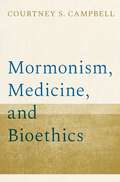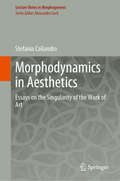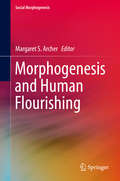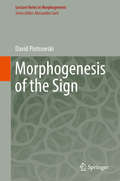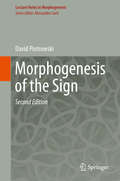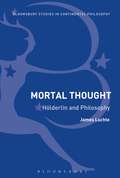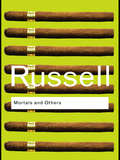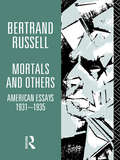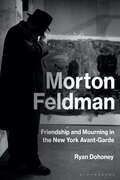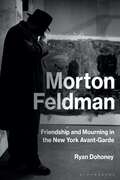- Table View
- List View
Mormonism, Empathy, and Aesthetics: Beholding the Body
by Gary EttariThis book analyzes the role that the physical body plays in foundational Mormon doctrine, and claims that such an analysis reveals a model of empathy that has significant implications for the field of Mormon aesthetics. This volume achieves three main goals: It elucidates the Mormonism's relationship with the body, it illuminates Mormonism’s traditional approaches to understanding and appreciating art, and it suggests that the body as Mormonism conceives of it allows for the employment of an aesthetic framework rooted in bodily empathy rather than traditional Christian or Mormon moral values per se. In support of this argument, several chapters of the book apply Mormonism’s theology of the body to paintings and poems by contemporary Mormon artists and writers. An examination of those works reveals that the seeds of a new Mormon aesthetic are germinating, but have yet to significantly shift traditional Mormon thought regarding the role and function of art.
Mormonism, Medicine, and Bioethics
by Courtney S. CampbellMormonism, Medicine, and Bioethics provides the first comprehensive treatment of principles and positions on questions of bioethics encountered by members, professionals, and ecclesiastical leaders of The Church of Jesus Christ of Latter-day Saints (LDS or Mormon). The book addresses three fundamental features of a coherent religious bioethics: precepts for practical decision-making, general ethical principles, and core religious convictions that give a distinctive motivation for personal, communal, and professional integrity. LDS ethical principles of love, hospitality to strangers, covenantal solidarity, justice, and moral agency are integrated with central topics in bioethics including abortion, genetic testing and enhancements, in vitro fertilization, medical assisted death, medicinal marijuana, neonatal intensive care, organ donation, preventive health care, universal access to care, and vaccinations. This book uses first-person experiences to give voice to the lived moral realities of Latter-day Saints as they experience difficult and wrenching ethical questions and choices as persons, family members, community members, professionals, and as citizens within the context of their distinctive faith convictions. It situates these communal conversations within the broader discourse of bioethics and thereby supports both bioethics and religious literacy. Mormonism, Medicine, and Bioethics also examines circumstances in which The Church of Jesus Christ of Latter-day Saints engages in a moral witness of its values on matters of public policy, such as legalization of physician-assisted death, of elective abortion, and of medicinal marijuana. The book concludes with a distinctive normative argument on why LDS ethical principles and practices require support of universal access to an adequate level of health care for all persons. It provides an appendix of significant LDS ecclesiastical policies on medical, health, and moral issues, making it a definitive educational and reference compilation.
Mormonism, Medicine, and Bioethics
by Courtney S. CampbellMormonism, Medicine, and Bioethics provides the first comprehensive treatment of principles and positions on questions of bioethics encountered by members, professionals, and ecclesiastical leaders of The Church of Jesus Christ of Latter-day Saints (LDS or Mormon). The book addresses three fundamental features of a coherent religious bioethics: precepts for practical decision-making, general ethical principles, and core religious convictions that give a distinctive motivation for personal, communal, and professional integrity. LDS ethical principles of love, hospitality to strangers, covenantal solidarity, justice, and moral agency are integrated with central topics in bioethics including abortion, genetic testing and enhancements, in vitro fertilization, medical assisted death, medicinal marijuana, neonatal intensive care, organ donation, preventive health care, universal access to care, and vaccinations. This book uses first-person experiences to give voice to the lived moral realities of Latter-day Saints as they experience difficult and wrenching ethical questions and choices as persons, family members, community members, professionals, and as citizens within the context of their distinctive faith convictions. It situates these communal conversations within the broader discourse of bioethics and thereby supports both bioethics and religious literacy. Mormonism, Medicine, and Bioethics also examines circumstances in which The Church of Jesus Christ of Latter-day Saints engages in a moral witness of its values on matters of public policy, such as legalization of physician-assisted death, of elective abortion, and of medicinal marijuana. The book concludes with a distinctive normative argument on why LDS ethical principles and practices require support of universal access to an adequate level of health care for all persons. It provides an appendix of significant LDS ecclesiastical policies on medical, health, and moral issues, making it a definitive educational and reference compilation.
Morning Hours: Lectures on God's Existence (Studies in German Idealism #12)
by Moses MendelssohnThe last work published by Moses Mendelssohn during his lifetime, Morning Hours (1785) is also the most sustained presentation of his mature epistemological and metaphysical views, all elaborated in the service of presenting proofs for the existence of God. But Morning Hours is much more than a theoretical treatise. It also plays a central role in the drama of the Pantheismusstreit, Mendelssohn's "dispute" with F. H. Jacobi over the nature and scope of Lessing's attitude toward Spinoza and "pantheism". As the latest salvo in a war of texts with Jacobi, Morning Hours is also Mendelssohn's attempt to set the record straight regarding his beloved Lessing in this connection, not least by demonstrating the absence of any practical (i.e., religious or moral) difference between theism and a "purified pantheism".
Morocco: The Islamist Awakening and Other Challenges
by Marvine HoweIn Morocco, Marvine Howe, a former correspondent for The New York Times, presents an incisive and comprehensive review of the Moroccan kingdom and its people, past and present. She provides a vivid and frank portrait of late King Hassan, whom she knew personally and credits with laying the foundations of a modern, pro-Western state and analyzes the pressures his successor, King Mohammed VI has come under to transform the autocratic monarchy into a full-fledged democracy. Howe addresses emerging issues and problems--equal rights for women, elimination of corruption and correction of glaring economic and social disparities--and asks the fundamental question: can this ancient Muslim kingdom embrace western democracy in an era of deepening divisions between the Islamic world and the West?
Morocco: The Islamist Awakening and Other Challenges
by Marvine HoweIn Morocco, Marvine Howe, a former correspondent for The New York Times, presents an incisive and comprehensive review of the Moroccan kingdom and its people, past and present. She provides a vivid and frank portrait of late King Hassan, whom she knew personally and credits with laying the foundations of a modern, pro-Western state and analyzes the pressures his successor, King Mohammed VI has come under to transform the autocratic monarchy into a full-fledged democracy. Howe addresses emerging issues and problems--equal rights for women, elimination of corruption and correction of glaring economic and social disparities--and asks the fundamental question: can this ancient Muslim kingdom embrace western democracy in an era of deepening divisions between the Islamic world and the West?
Morphodynamics in Aesthetics: Essays on the Singularity of the Work of Art (Lecture Notes in Morphogenesis)
by Stefania CaliandroThis book deals with the complexity of art by focusing on the singularity of the work of art. Gathering a selection of writings in art theory and semiotics, it explores the question of apprehending art from its perceptual aspects to aesthetic comprehension and understanding. Theoretical enquiries focus in particular on the dynamics of the perception of forms, the semiotic value of colour, the aesthetic phenomenon of empathy, the function of vision in relation to other senses and its faculty to lead, in a substantial way, to the embodiment of sense. These theoretical points are constantly observed with reference to the analysis of works of art, especially from the beginning of the modern era, when a renovated psychophysical approach oriented the evolution of contemporary aesthetics. Research into art theories sheds light on how differentials in topologic positions, dimensions, relationships and tones contribute to the arising of forms and colours in perception, and affect the perceiver. The essays presented address in different ways the emergence of sense, by conceiving it as deeply anchored to the dynamics of perception, in addition to the cognitive disposition and knowledge, regardless of whether or not the subject (artist or beholder) is aware of these processes. Through in-depth analyses identifying to what extent the aesthetic moment builds on perceptual and semiotic processes, works of art are revealed to be singularities, reflecting the correlation with morphodynamics in the sciences.
Morphogenesis and Human Flourishing (Social Morphogenesis)
by Margaret S. ArcherThis book, the last volume in the Social Morphogenesis series, examines whether or not a Morphogenic society can foster new modes of human relations that could exercise a form of ‘relational steering’, protecting and promoting a nuanced version of the good life for all. It analyses the way in which the intensification of morphogenesis and the diminishing of morphostasis impact upon human flourishing. The book links intensified morphogenesis to promoting human flourishing based on the assumption that new opportunities open up novel experiences, skills, and modes of communication that appeal to talents previously lacking any outlet or recognition. It proposes that equality of opportunity would increase as ascribed characteristics diminished in importance, and it could be maintained as the notion of achievement continued to diversify. Digitalization has opened the cultural ‘archive’ for more to explore and, as it expands exponentially, so do new complementary compatibilities whose development foster yet further opportunities. If more people can do more of what they do best, these represent stepping stones towards the ‘good life’ for more of them.
Morphogenesis and Individuation (Lecture Notes in Morphogenesis)
by Alessandro Sarti Federico Montanari Francesco GalofaroThis contributed volume aims to reconsider the concept of individuation, clarifying its articulation with respect to contemporary problems in perceptual, neural, developmental, semiotic and social morphogenesis. The authors approach the ontogenetical issue by taking into account the morphogenetic process, involving the concept of individuation proposed by Gilbert Simondon and Gilles Deleuze. The target audience primarily comprises experts in the field but the book may also be beneficial for graduate students. The challenge of the genesis and constitution of “units” has always been at the center of philosophical and scientific research. This ontogenetical issue is common to every discipline but it is articulated in different ways: in phenomenology of perception the constitution of perceptual units is at the base of gestalt field theories, in theoretical neuroscience synchronized neural assemblies are considered as correlates of conscious processes, in developmental embryogenesis the constitution of organs is the principle outcome of morphodynamic evolution while in social morphogenesis the constitution of coherent units is common to segmentary, gerarchic and functional differentiation.
Morphogenesis of the Sign: From Morphodynamics To Neurosciences (Lecture Notes in Morphogenesis)
by David PiotrowskiThis book develops a morphodynamical approach to linguistic and sign structures as an integrated response to multilevel and interrelated problems in semiolinguistic research. More broadly, the content is linked to the realities of living speech through a connection (via the concept of diacriticity) with the Merleau-Pontian phenomenology, and beyond the formal determinations of a semiolinguistic system and its calculus. Such problems are mainly epistemological (concerning the nature and legitimate scope of semiolinguistic knowledge), empirical (concerning the observational device and the data’s composition), and theoretical (regarding the choice of a conceptual and formalized explicative frame). With regard to theory, the book introduces a morphodynamical architecture of linguistic signs and operations as a suitable mathematization of Saussurean theory. The Husserlian phenomenological signification of this formal apparatus is then established, and, from an empirical standpoint, its compatibility with neurobiological experimental results is discussed.
Morphogenesis of the Sign: From Morphodynamics To Neurosciences (Lecture Notes in Morphogenesis)
by David PiotrowskiThis book develops a morphodynamical approach to linguistic and sign structures as an integrated response to multilevel and interrelated problems in semiolinguistic research. More broadly, the content is linked to the realities of living speech through a connection (via the concept of diacriticity) with the Merleau-Pontian phenomenology, and beyond the formal determinations of a semiolinguistic system and its calculus. Such problems are mainly epistemological (concerning the nature and legitimate scope of semiolinguistic knowledge), empirical (concerning the observational device and the data’s composition), and theoretical (regarding the choice of a conceptual and formalized explicative frame). With regard to theory, the book introduces a morphodynamical architecture of linguistic signs and operations as a suitable mathematization of Saussurean theory. The Husserlian phenomenological signification of this formal apparatus is then established, and, from an empirical standpoint, its compatibility with neurobiological experimental results is discussed.
Mortal Subjects
by Christina HowellsThis wide ranging and challenging book explores the relationship between subjectivity and mortality as it is understood by a number of twentieth-century French philosophers including Sartre, Lacan, Levinas and Derrida. Making intricate and sometimes unexpected connections, Christina Howells draws together the work of prominent thinkers from the fields of phenomenology and existentialism, religious thought, psychoanalysis, and deconstruction, focussing in particular on the relations between body and soul, love and death, desire and passion. From Aristotle through to contemporary analytic philosophy and neuroscience the relationship between mind and body (psyche and soma, consciousness and brain) has been persistently recalcitrant to analysis, and emotion (or passion) is the locus where the explanatory gap is most keenly identified. This problematic forms the broad backdrop to the work’s primary focus on contemporary French philosophy and its attempts to understand the intimate relationship between subjectivity and mortality, in the light not only of the ‘death’ of the classical subject but also of the very real frailty of the subject as it lives on, finite, desiring, embodied, open to alterity and always incomplete. Ultimately Howells identifies this vulnerability and finitude as the paradoxical strength of the mortal subject and as what permits its transcendence. Subtle, beautifully written, and cogently argued, this book will be invaluable for students and scholars interested in contemporary theories of subjectivity, as well as for readers intrigued by the perennial connections between love and death.
Mortal Subjects
by Christina HowellsThis wide ranging and challenging book explores the relationship between subjectivity and mortality as it is understood by a number of twentieth-century French philosophers including Sartre, Lacan, Levinas and Derrida. Making intricate and sometimes unexpected connections, Christina Howells draws together the work of prominent thinkers from the fields of phenomenology and existentialism, religious thought, psychoanalysis, and deconstruction, focussing in particular on the relations between body and soul, love and death, desire and passion. From Aristotle through to contemporary analytic philosophy and neuroscience the relationship between mind and body (psyche and soma, consciousness and brain) has been persistently recalcitrant to analysis, and emotion (or passion) is the locus where the explanatory gap is most keenly identified. This problematic forms the broad backdrop to the work’s primary focus on contemporary French philosophy and its attempts to understand the intimate relationship between subjectivity and mortality, in the light not only of the ‘death’ of the classical subject but also of the very real frailty of the subject as it lives on, finite, desiring, embodied, open to alterity and always incomplete. Ultimately Howells identifies this vulnerability and finitude as the paradoxical strength of the mortal subject and as what permits its transcendence. Subtle, beautifully written, and cogently argued, this book will be invaluable for students and scholars interested in contemporary theories of subjectivity, as well as for readers intrigued by the perennial connections between love and death.
Mortal Thought: Hölderlin and Philosophy (Bloomsbury Studies in Continental Philosophy)
by James LuchteMortal Thought seeks to illustrate the artistic and philosophical contexts for Hölderlin's poetic thought and to trace his profound impact upon subsequent philosophy, most notably Nietzsche, the Frankfurt School, Heidegger and Post-structuralism. Beginning with the point of departure of Hölderlin in Kant and Fichte, Mortal Thought outlines the novel philosophical innovations of Hölderlin, and their influence upon philosophy from the 19th century to the present day. A renewed appreciation of Hölderlin will allow us to retrieve an authentic philosophy for our own era. Mortal Thought lays out a concise, clear and comprehensive account of the emergence of Hölderlin as philosopher and poet, of his influence upon the four dominant strands of Continental philosophy - Nietzsche, Heidegger, Critical Theory and Poet-structuralism - and of his relevance for us in our own era.
Mortal Thought: Hölderlin and Philosophy (Bloomsbury Studies in Continental Philosophy)
by James LuchteMortal Thought seeks to illustrate the artistic and philosophical contexts for Hölderlin's poetic thought and to trace his profound impact upon subsequent philosophy, most notably Nietzsche, the Frankfurt School, Heidegger and Post-structuralism. Beginning with the point of departure of Hölderlin in Kant and Fichte, Mortal Thought outlines the novel philosophical innovations of Hölderlin, and their influence upon philosophy from the 19th century to the present day. A renewed appreciation of Hölderlin will allow us to retrieve an authentic philosophy for our own era. Mortal Thought lays out a concise, clear and comprehensive account of the emergence of Hölderlin as philosopher and poet, of his influence upon the four dominant strands of Continental philosophy - Nietzsche, Heidegger, Critical Theory and Poet-structuralism - and of his relevance for us in our own era.
Mortals and Others
by Bertrand RussellBetween 1931 and 1935, Bertrand Russell contributed some 156 essays to the literary pages of the American newspaper New York American. These were often fun, humorous observations on the very real issues of the day, such as the Depression, the rise of Nazism and Prohibition, to more perennial themes such as love, parenthood, education and friendship. Available for the first time in the Routledge Classics series in a single volume, this pithy, provocative and often-personal collection of essays brings together the very best of Russell’s many contributions to the New York American, and proves just as engaging for today’s readers as they were in the 1930s.
Mortals and Others: American Essays 1931-1935 (Routledge Classics Ser.)
by Bertrand RussellBetween 1931 and 1935, Bertrand Russell contributed some 156 essays to the literary pages of the American newspaper New York American. These were often fun, humorous observations on the very real issues of the day, such as the Depression, the rise of Nazism and Prohibition, to more perennial themes such as love, parenthood, education and friendship. Available for the first time in the Routledge Classics series in a single volume, this pithy, provocative and often-personal collection of essays brings together the very best of Russell’s many contributions to the New York American, and proves just as engaging for today’s readers as they were in the 1930s.
Mortals and Others, Volume I: American Essays 1931-1935
by Bertrand RussellThis collection of essays and journalism cover a wide range of topics, from balancing prosperity and public expenditure or the mental differences between boys and girls to 'who may use lipstick'. Mortal and Others shows the serious and non-serious side of Russell's personality and work. It provides a lively and revealing introduction to Russell's thought for all readers. First published in 1975, Mortals and Others is at last available in paperback with a new introduction by John Slater.
Mortals and Others, Volume I: American Essays 1931-1935
by Bertrand RussellThis collection of essays and journalism cover a wide range of topics, from balancing prosperity and public expenditure or the mental differences between boys and girls to 'who may use lipstick'. Mortal and Others shows the serious and non-serious side of Russell's personality and work. It provides a lively and revealing introduction to Russell's thought for all readers. First published in 1975, Mortals and Others is at last available in paperback with a new introduction by John Slater.
Mortals and Others, Volume II: American Essays 1931-1935
by Bertrand Russell Harry Ruja'Every man would like to be God, if it were possible; some few find it difficult to admit the impossibility.' - Bertrand Russell From 1931-1935 Bertrand Russell was one of the regular contributors to the literary pages of the New York American, together with other distinguished authors, such as Aldous Huxley and Vita Sackville-West. Mortals and Others Volume II presents a further selection of his essays, ranging from the politically correct, to the perfectly obscure: from The Prospects of Democracy to Men Versus Insects. Even though written in the politically heated climate of the 1930s, these essays are surprisingly topical and engaging for the present day reader. Volume II of Mortals and Others serves as a splendid, fresh introduction to the compassionate eclecticism of Bertrand Russell's mind.
Mortals and Others, Volume II: American Essays 1931-1935
by Bertrand Russell Harry Ruja'Every man would like to be God, if it were possible; some few find it difficult to admit the impossibility.' - Bertrand Russell From 1931-1935 Bertrand Russell was one of the regular contributors to the literary pages of the New York American, together with other distinguished authors, such as Aldous Huxley and Vita Sackville-West. Mortals and Others Volume II presents a further selection of his essays, ranging from the politically correct, to the perfectly obscure: from The Prospects of Democracy to Men Versus Insects. Even though written in the politically heated climate of the 1930s, these essays are surprisingly topical and engaging for the present day reader. Volume II of Mortals and Others serves as a splendid, fresh introduction to the compassionate eclecticism of Bertrand Russell's mind.
Morton Feldman: Friendship and Mourning in the New York Avant-Garde
by Ryan DohoneyMorton Feldman: Friendship and Mourning in the New York Avant-Garde documents the collaborations and conflicts essential to the history of the post-war avant-garde. It offers a study of composer Morton Feldman's associations and friendships with artists like John Cage, Jackson Pollock, Philip Guston, Frank O'Hara, Charlotte Moorman, and others. Arguing that friendship and mourning sustained the collective aesthetics of the New York School, Dohoney has written an emotional and intimate revision of New York modernism from the point of view of Feldman's agonistic community.
Morton Feldman: Friendship and Mourning in the New York Avant-Garde
by Ryan DohoneyMorton Feldman: Friendship and Mourning in the New York Avant-Garde documents the collaborations and conflicts essential to the history of the post-war avant-garde. It offers a study of composer Morton Feldman's associations and friendships with artists like John Cage, Jackson Pollock, Philip Guston, Frank O'Hara, Charlotte Moorman, and others. Arguing that friendship and mourning sustained the collective aesthetics of the New York School, Dohoney has written an emotional and intimate revision of New York modernism from the point of view of Feldman's agonistic community.
The Mosaic Constitution: Political Theology and Imagination from Machiavelli to Milton
by Graham HammillIt is a common belief that scripture has no place in modern, secular politics. Graham Hammill challenges this notion in The Mosaic Constitution, arguing that Moses’s constitution of Israel, which created people bound by the rule of law, was central to early modern writings about government and state. Hammill shows how political writers from Machiavelli to Spinoza drew on Mosaic narrative to imagine constitutional forms of government. At the same time, literary writers like Christopher Marlowe, Michael Drayton, and John Milton turned to Hebrew scripture to probe such fundamental divisions as those between populace and multitude, citizenship and race, and obedience and individual choice. As these writers used biblical narrative to fuse politics with the creative resources of language, Mosaic narrative also gave them a means for exploring divine authority as a product of literary imagination. The first book to place Hebrew scripture at the cutting edge of seventeenth-century literary and political innovation, The Mosaic Constitution offers a fresh perspective on political theology and the relations between literary representation and the founding of political communities.
The Mosaic Constitution: Political Theology and Imagination from Machiavelli to Milton
by Graham HammillIt is a common belief that scripture has no place in modern, secular politics. Graham Hammill challenges this notion in The Mosaic Constitution, arguing that Moses’s constitution of Israel, which created people bound by the rule of law, was central to early modern writings about government and state. Hammill shows how political writers from Machiavelli to Spinoza drew on Mosaic narrative to imagine constitutional forms of government. At the same time, literary writers like Christopher Marlowe, Michael Drayton, and John Milton turned to Hebrew scripture to probe such fundamental divisions as those between populace and multitude, citizenship and race, and obedience and individual choice. As these writers used biblical narrative to fuse politics with the creative resources of language, Mosaic narrative also gave them a means for exploring divine authority as a product of literary imagination. The first book to place Hebrew scripture at the cutting edge of seventeenth-century literary and political innovation, The Mosaic Constitution offers a fresh perspective on political theology and the relations between literary representation and the founding of political communities.

